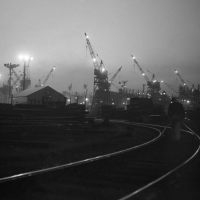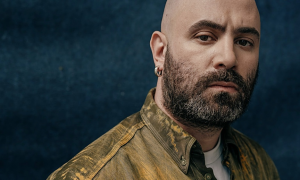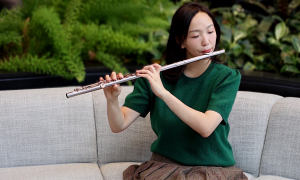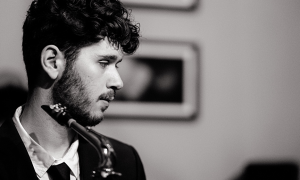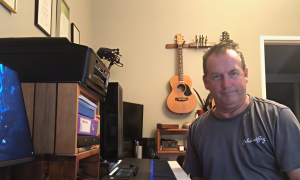Home » Jazz Articles » Take Five With... » Take Five with Bryan S. Wright
Take Five with Bryan S. Wright
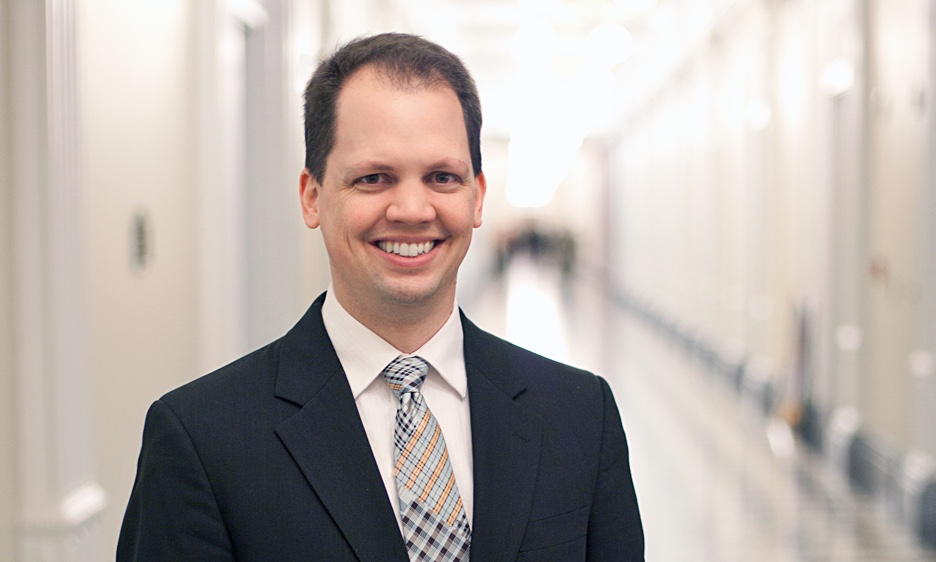
Meet Bryan S. Wright
Bryan S. Wright is a pianist and Grammy-nominated musicologist based in Pittsburgh, Pennsylvania. Since 2003, he has been the Executive Producer of Rivermont Records, a label dedicated to preserving and promoting ragtime and early jazz styles through reissues of historic recordings alongside new recordings by today's most celebrated ragtime and early jazz musicians. He has been Artist in Residence for the Scott Joplin International Ragtime Foundation and currently serves as the Artistic Director for the organization's annual Scott Joplin Festival. Bryan has performed and lectured on ragtime across the United States and abroad, with notable appearances at the JVC Jazz Festival in New York, the West Coast Ragtime Festival in Sacramento, California, and major ragtime and jazz festivals in Argentina and Japan. He has released two solo albums (Syncopated Musings and Breakin' Notes) in addition to collaborative albums with Brian Holland, Danny Coots, and Martin Spitznagel. Currently, Bryan teaches in the Music Department of the University of Pittsburgh.Instruments:
Piano, violin/violaTeachers and/or influences?
As a toddler, I was given a battery-operated record player, which quickly became my favorite toy and also my first "teacher" and musical influence. While other kids in my preschool toted around toy trucks, dolls, or action figures, I always had a fistful of 45s. In addition to the usual kiddie records, I remember especially liking hand-me-down discs from neighbors and relatives by the likes of Paul McCartney and Wings and Brewer and Shipley. The record-collecting bug bit me hard at that early age—a habit I haven't been able to shake since! As a 4-year-old, I asked my parents to enroll me in piano lessons. I studied classical piano through high school with a local teacher, Sandra Horwege, then on through college at William and Mary with Christine Niehaus. Along the way, my musical tastes took a sharp turn into the realm of ragtime, early jazz, and "vintage pop." The first time I heard the cornet of Bix Beiderbecke, I was hooked. His tone, rhythmic variety, and melodic inventiveness have fascinated me since high school; I count his records foremost among my musical influences to this day. My experiences learning and playing a wide variety of music as an undergraduate music major (ranging from Appalachian fiddle lessons with Mike Seeger to studies of Middle Eastern music with Anne Rasmussen) led me to pursue a graduate degree in musicology, and I completed my PhD at the University of Pittsburgh in 2016.I knew I wanted to be a musician when...
I vividly remember attending a community talent show at age 4 where—among other acts—I heard someone play a piano selection from Mendelssohn's "Songs Without Words." I was mesmerized, and I knew at that moment that I wanted to become a musician too. At the end of the show, I asked my parents for piano lessons. I'm sure they thought my interest was a phase that would pass, but the memory of that performance stuck with me, and I kept asking. Eventually they relented and rented a piano, and I started lessons.Your sound and approach to music.
I play a lot of ragtime (both old and newly-composed) and early styles of jazz piano. It can be easy to fall into the trap of playing this type of music in a mechanical way, prioritizing the notes and rhythms at the expense of expression or a sense of drama. With careful attention to dynamics, articulation, phrasing, and voice shaping (while still maintaining a driving rhythm), I think many rags and early jazz pieces can be quite satisfying to play and to hear—and convey more depth and "heart" than most people credit them with having. I strive always to engage and surprise audiences by emphasizing the lyrical and dynamic aspects of this music that often get buried by flashy embellishments.Your teaching approach
Aside from refining technique (something I still work on myself), I encourage students to think about and articulate (in words) why a particular piece of music or a particular performance of a piece moves them. Of course, the magic of music is that it is capable of conveying complex emotions and feelings more fluently than words, but I still encourage students to look and listen for the specific features of a piece of music that affect them and try to articulate the "how" and "why" so they can more effective performers or listeners. Why is a crescendo or ritardando appropriate here? Or why not? Why should a particular chord be played staccato rather than left to ring out? These questions do not necessarily have right and wrong answers, but I hope that students can play or listen with purpose so that music becomes even more meaningful.Your dream band
I am fortunate: my dream band actually exists! The Chicago Cellar Boys (of—where else—Chicago!) play a variety of jazz and popular music of the 1920s and '30s with all the youthful vim and vigor of the best musicians of that era, intermixing classics with forgotten, long-overlooked gems and even some exquisitely crafted originals. With Andy Schumm (cornet and reeds), John Otto (reeds), Natalie Scharf (reeds), Dave Bock (trombone and tube), Jimmy Barrett (banjo), and Paul Asaro (piano and vocals), the group is already a "dream assemblage" of many of my favorite musicians on their respective instruments, and with their combined enthusiasm and unmatched skill, they manage to make nearly 100-year-old jazz styles sound amazingly fresh. Check them out at the Honky Tonk BBQ next time you're in Chicago, or look for them online (YouTube, Spotify, etc.). Hearing them is an unforgettable experience.Road story: Your best or worst experience
In 2014 and 2015, I was invited to play for a jazz festival in Buenos Aires and at the American Embassy there. Getting there was one of the most miserable travel experiences I have had; my flight to Buenos Aires was diverted to Uruguay shortlybefore landing because of a major storm that closed the airport, leading to a multi-day ordeal culminating with an 80-mile-per-hour wild ride in a jitney bus, holding on for dear life as we whipped through the streets of Montevideo at 2 A.M. Once we got to Buenos Aires, however, it quickly became one of the best experiences of my musical life. The festival organizers and our hosts were very gracious, and the audiences that turned out were the most enthusiastic I have ever encountered. All of the concerts were sold out, with people packed into the aisles of the theater and a line stretching out the door and around the block. I played piano solos by Scott Joplin, Jelly Roll Morton, and Bix Beiderbecke, but when the applause and cheers of the audience swelled at the end of each piece, it might as well have been the Beatles on Ed Sullivan. They went wild! I've never had a reception like that anywhere else. To play for an audience that gave back with such passion and energy was an indescribably joyous experience.
Your favorite recording in your discography and why?
Have I mentioned that I like Bix Beiderbecke? (Haha!) In 2009, I was in Tokyo for a couple months before my wedding there, and I had a late-night recording session on a gorgeous Hamburg Steinway grand during which I recorded Bix's four piano compositions: "Candlelights," "Flashes," "In the Dark," and "In a Mist." I had been playing them for several years, trying to get them to sound just the way I had always wanted to hear them. The pieces rank among my very favorite compositions for piano, but regrettably, Bix himself only ever recorded "In a Mist." The others I had only heard in performances by pianists that I thought played either too fast, covering up the exquisite harmonies, or too slow and sentimental, without any of Bix's characteristic rhythmic drive. I felt that the pieces should be approached with something of the French impressionists in mind—Debussy and Ravel especially. Their music often has a steely "coolness" about it that can make it difficult to describe the emotions it elicits. To take two well-known examples: Debussy's "Clouds" and Ravel's "Pavane pour une infante défunte" are supremely gorgeous pieces, but they are emotionally ambiguous. That's how I feel about Bix's piano pieces. After an hour in Tokyo's bustling subways, picking up a bento box dinner on the way, I got to the theatre where the session was to be held.Suddenly the crowds and bright lights of Tokyo nightlife were gone. It was dark and very quiet. With no audience, I didn't need to be nervous. I was able to relax completely, and I just played the pieces for myself—the way I wanted to hear them. There are a few things I might do differently if I were performing or recording them now, but I'm still happy with how they turned out. I put those Tokyo recordings on my second album, Breakin' Notes, and also released the four as a vinyl 78 rpm 2-record set. I wouldn't dare claim they are the "best" versions of these pieces out there, but they are my personal favorites among the recordings I have made because I love the compositions, and I feel that I achieved what I set out to do with my performances of them.
What do you think is the most important thing you are contributing musically?
In 2003, as a musicology major in college, I launched Rivermont Records from my dorm room, with the goal of issuing high-quality recordings of ragtime, vintage jazz, and pre—swing dance bands. These were musical styles that were very meaningful to me, but, at the time, I didn't see many labels willing to invest much in producing either newrecordings or reissues. (A notable exception was Bob Erdos's brilliant Stomp Off label, which by that time was already starting to wind down production.) In the twenty years since, I've had the good fortune to work with and record some truly exceptional musicians— soloists and ensembles—ranging from Richard Dowling, Carl Sonny Leyland, Roya Naldi, Adam Swanson, Vanessa Tagliabue Yorke, and Martin Spitznagel to the Fat Babies, the Peacherine Ragtime Society Orchestra, Vince Giordano's Nighthawks, the Chicago Cellar Boys, and so many others. Both as a pianist and record producer, I like to think that my most important contribution is aiding and encouraging the rediscovery, performance, and recording of long overlooked works by composers of the ragtime and early jazz eras while also championing the works of contemporary composers who write in these styles—all in an effort to help audiences of today fall in love with the variety and wealth of music in these styles. It's easy to write off ragtime as little more than simplistic "ice cream truck music," but the reality is that there have been a lot of very sophisticated and engaging works written under the banner of ragtime and early jazz.
The first jazz album I bought was:
As a kid (5-10 years old), I had a number of hand-me-down jazz LPs ranging from Dave Brubeck to Turk Murphy to Charlie Christian, but the first jazz album I bought with my own money was the 2-CD set "The Indispensable Bix Beiderbecke" on French RCA. I was with my family on a vacation in Alaska, and I bought it in the Anchorage Borders bookstore. At that point, my musical tastes steered mostly towards early rock 'n' roll (Elvis, Buddy Holly, the Beatles... ), but I had chanced to hear a couple of Bix's records a few weeks prior to the Alaska trip. On a whim, I bought that CD and ended up listening to it nonstop on headphones for the rest of the trip (to the annoyance of my parents)—and regularly for many years afterwards. It completely reset my understanding of what jazz could be, and it reshaped my musical tastes almost overnight.Music you are listening to now:
The Lovestruck Balladeers: The Lovestruck Balladeers (Self Prducedl)Miles Davis: Porgy and Bess (Columbia)
Dick Hyman, Kenny Davern, Dan Levinson, et al: One Step to Chicago (Rivermont)
Ben Webster: See You at the Fair (Impulse)
Ricky Nelson (I never lost my taste for early rock 'n' roll, and several of Nelson's early LPs have been in heavy rotation lately!)
Desert Island picks:
Bix Beiderbecke: Bix Restored (Origin Jazz Library)Glazunov: The Complete Symphonies and Concertos (José Serebrier, cond.) (Warner)
Frank Sinatra: The Voice (Columbia)
John Coltrane and Johnny Hartman: John Coltrane and Johnny Hartman (Impulse)
Teddy Wilson: School for Pianists (Merritt)
What are some of the essential requirements to keep jazz alive and growing?
Jazz has its roots in dance music, and at its heart, I think jazz needs to have an element of fun and playfulness. (That doesn't necessarily mean "silly.") It's O.K. to take jazz seriously, but to win new audiences and grow, I think jazz needs to keep its ability to surprise and delight. In any style of jazz, the minute the music becomes clinical and predictable, it loses the spark of life.
What is in the near future?
In July 2022, I completed a multi-year Rivermont project to issue George Avakian's production One Step to Chicago . The all-star album, headed up by Dick Hyman, Kenny Davern, and Dan Levinson, was conceived as a tribute to pioneering jazz clarinetist Frank Teschemacher and his musical pals from the so-called "Austin High Gang" of the late 1920s. The recording session in 1992 went brilliantly, but the record company that was to issue it backed out over financial concerns, and the album was shelved for nearly three decades. Working with the Avakian family, the New York Public Library, and the musicians themselves, Dan Levinson and I were finally able to see it issued, and it was gratifying when the Wall Street Journal cited it as "one of the best jazz albums of 2022."Looking ahead, I am working with several scholars, collectors, and engineers in the U.S. and England on a planned 4-CD set spotlighting ragtime recorded in London in the 1890s-1920s by both British and American musicians. Many American performers (both black and white) toured England at the time, and many of them made records while there. Many of these records are quite rare and largely unknown today since they have seldom—if ever—been reissued. For anyone with an interest in the early days of jazz, I think these historic recordings will provide an eye-and ear-opening experience!
What is your greatest fear when you perform?
As a pianist, I must make do with whatever piano a particular venue has. (I'm not at the level where I can afford to travel with my own instrument!) Often, the pianos are fine—and sometimes exceptionally good. But every so often, a real lemon turns up: sticking keys, non-sounding notes, uneven regulation, squeaky or non-functional pedal, etc. I really dread ending up with one of those!What song would you like played at your funeral?
"Northern Lights Rag" by Max Keenlyside. It's one of the most gorgeous melodies of the 21 st century so far, with a nostalgic, bittersweet tinge and a soaring, triumphant ending.What is your favorite song to whistle or sing in the shower?
It changes from day-to-day and week-to-week depending on what I happen to be listening to at the time, but one tune that often pops into my head at shower time for seemingly no reason is a 1930 song called "You Brought a New Kind of Love to Me." I heard a Maurice Chevalier record of it years ago, and it really lodged in my brain. It's not exactly a "favorite" of mine, but—damn!—it's catchy!By Day:
I teach in the music department at the University of Pittsburgh.If I weren't a jazz musician, I would be a:
Hiking guide at a national park in a western U.S. state. I love to visit and hike around parks like Zion, Bryce Canyon, Arches, etc.If I could have dinner with anyone from history, who would it be and why?
I would very much like to have dinner with either Scott Joplin or Bix Beiderbecke—two musical idols whose music I have come to know intimately, but whose personalities remain enigmatic. From outside the realm of music, though, I have always been fascinated by medieval European history, and I would love to have dinner with an "ordinary" person of the 12th or 13th centuries to better understand their worldview at that time and what day-to-day life was like. Or maybe Leonardo Da Vinci. I'll bet he would have a lot of interesting things to talk about!Tags
Take Five With...
Bryan S. Wright
AAJ Staff
EMPKT PR
United States
Pennsylvania
Pittsburgh
Paul McCartney
Honky Tonk BBQ
Chicago
Scott Joplin
Jelly Roll Morton
Bix Beiderbecke
Richard Dowling
Carl Sonny Leyland
Roya Naldi,
Adam Swanson
Vanessa Tagliabue Yorke
Martin Spitznagel
Vince Giordano
Dave Brubeck
Turk Murphy
Charlie Christian
Miles Davis
Dick Hyman
Kenny Davern
ben webster
frank sinatra
John Coltrane
Johnny Hartman
Teddy Wilson
PREVIOUS / NEXT
Support All About Jazz
 All About Jazz has been a pillar of jazz since 1995, championing it as an art form and, more importantly, supporting the musicians who make it. Our enduring commitment has made "AAJ" one of the most culturally important websites of its kind, read by hundreds of thousands of fans, musicians and industry figures every month.
All About Jazz has been a pillar of jazz since 1995, championing it as an art form and, more importantly, supporting the musicians who make it. Our enduring commitment has made "AAJ" one of the most culturally important websites of its kind, read by hundreds of thousands of fans, musicians and industry figures every month.



